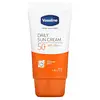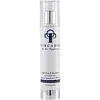What's inside
What's inside
 Key Ingredients
Key Ingredients

 Benefits
Benefits

 Concerns
Concerns

 Ingredients Side-by-side
Ingredients Side-by-side

Water
Skin ConditioningGlycerin
HumectantEthylhexyl Methoxycinnamate
UV AbsorberTitanium Dioxide
Cosmetic ColorantCetearyl Ethylhexanoate
EmollientCyclopentasiloxane
Emollient4-Methylbenzylidene Camphor
UV AbsorberButyl Methoxydibenzoylmethane
UV AbsorberEthylhexyl Salicylate
UV AbsorberOctocrylene
UV AbsorberCyclohexasiloxane
EmollientPoly C10-30 Alkyl Acrylate
Emulsion StabilisingSilica
AbrasiveCetearyl Alcohol
EmollientGlyceryl Stearate
EmollientSorbitan Sesquioleate
EmulsifyingPEG-100 Stearate
Triceteareth-4 Phosphate
EmulsifyingPolysorbate 80
EmulsifyingPEG-2 Stearate
EmulsifyingGlycol Stearate
EmollientTromethamine
BufferingHomosalate
Skin ConditioningBenzotriazolyl Dodecyl P-Cresol
UV AbsorberPetrolatum 0.4%
EmollientCarbomer
Emulsion StabilisingHydroxyacetophenone
AntioxidantPotassium Cetyl Phosphate
EmulsifyingSodium Stearoyl Glutamate
CleansingPhenylbenzimidazole Sulfonic Acid
UV AbsorberParfum
MaskingDimethicone
EmollientEthylhexylglycerin
Skin ConditioningLinalool
PerfumingDisodium EDTA
Hexyl Cinnamal
PerfumingBenzyl Alcohol
PerfumingWater, Glycerin, Ethylhexyl Methoxycinnamate, Titanium Dioxide, Cetearyl Ethylhexanoate, Cyclopentasiloxane, 4-Methylbenzylidene Camphor, Butyl Methoxydibenzoylmethane, Ethylhexyl Salicylate, Octocrylene, Cyclohexasiloxane, Poly C10-30 Alkyl Acrylate, Silica, Cetearyl Alcohol, Glyceryl Stearate, Sorbitan Sesquioleate, PEG-100 Stearate, Triceteareth-4 Phosphate, Polysorbate 80, PEG-2 Stearate, Glycol Stearate, Tromethamine, Homosalate, Benzotriazolyl Dodecyl P-Cresol, Petrolatum 0.4%, Carbomer, Hydroxyacetophenone, Potassium Cetyl Phosphate, Sodium Stearoyl Glutamate, Phenylbenzimidazole Sulfonic Acid, Parfum, Dimethicone, Ethylhexylglycerin, Linalool, Disodium EDTA, Hexyl Cinnamal, Benzyl Alcohol
Butyl Methoxydibenzoylmethane 3%
UV AbsorberEthylhexyl Methoxycinnamate 7.5%
UV AbsorberOctocrylene 2.8%
UV AbsorberWater
Skin ConditioningC12-15 Alkyl Benzoate
AntimicrobialEthylhexyl Methoxycrylene
Skin ConditioningGlycerin
HumectantSilica
AbrasiveVp/Eicosene Copolymer
Dimethicone
EmollientCyclopentasiloxane
EmollientPotassium Cetyl Phosphate
EmulsifyingPEG-100 Stearate
Dimethyl Capramide
Emulsion StabilisingHydrogenated Palm Glycerides
EmollientCitrus Aurantium Dulcis Peel Extract
Emulsion StabilisingCitrus Grandis Peel Extract
AstringentPrunus Armeniaca Fruit Extract
Skin ConditioningAniba Rosaeodora Wood Extract
MaskingLecithin
EmollientVitis Vinifera Fruit Cell Extract
Skin ConditioningDiaminopropionoyl Tripeptide-33
Skin ConditioningVanilla Planifolia Fruit Extract
Skin ConditioningDimethylmethoxy Chromanol
AntioxidantAcrylamide/Sodium Acryloyldimethyltaurate Copolymer
Emulsion StabilisingCitrus Aurantifolia Peel Extract
CleansingCaprylyl Glycol
EmollientDisodium EDTA
Xanthan Gum
EmulsifyingCyclohexasiloxane
EmollientCaprylic/Capric Triglyceride
MaskingSorbitan Oleate
EmulsifyingGlyceryl Stearate
EmollientGlyceryl Distearate
EmollientHexylene Glycol
EmulsifyingIsohexadecane
EmollientPolysilicone-11
Polysorbate 80
EmulsifyingPhenoxyethanol
PreservativeIsomalt
HumectantSodium Benzoate
MaskingLimonene
PerfumingLinalool
PerfumingButyl Methoxydibenzoylmethane 3%, Ethylhexyl Methoxycinnamate 7.5%, Octocrylene 2.8%, Water, C12-15 Alkyl Benzoate, Ethylhexyl Methoxycrylene, Glycerin, Silica, Vp/Eicosene Copolymer, Dimethicone, Cyclopentasiloxane, Potassium Cetyl Phosphate, PEG-100 Stearate, Dimethyl Capramide, Hydrogenated Palm Glycerides, Citrus Aurantium Dulcis Peel Extract, Citrus Grandis Peel Extract, Prunus Armeniaca Fruit Extract, Aniba Rosaeodora Wood Extract, Lecithin, Vitis Vinifera Fruit Cell Extract, Diaminopropionoyl Tripeptide-33, Vanilla Planifolia Fruit Extract, Dimethylmethoxy Chromanol, Acrylamide/Sodium Acryloyldimethyltaurate Copolymer, Citrus Aurantifolia Peel Extract, Caprylyl Glycol, Disodium EDTA, Xanthan Gum, Cyclohexasiloxane, Caprylic/Capric Triglyceride, Sorbitan Oleate, Glyceryl Stearate, Glyceryl Distearate, Hexylene Glycol, Isohexadecane, Polysilicone-11, Polysorbate 80, Phenoxyethanol, Isomalt, Sodium Benzoate, Limonene, Linalool
Ingredients Explained
These ingredients are found in both products.
Ingredients higher up in an ingredient list are typically present in a larger amount.
Also known as Avobenzone, this ingredient is a chemical sunscreen filter that provides protection in the UV-A range.
Avobenzone is globally approved and is the most commonly used UV-A filter in the world.
Studies have found that avobenzone becomes ineffective when exposed to UV light (it is not photostable; meaning that it breaks down in sunlight). Because of this, formulations that include avobenzone will usually contain stabilizers such as octocrylene.
However, some modern formulations (looking at you, EU!) are able to stabilize avobenzone by coating the molecules.
Avobenzone does not protect against the UV-B range, so it's important to check that the sunscreen you're using contains other UV filters that do!
The highest concentration of avobenzone permitted is 3% in the US, and 5% in the EU.
Learn more about Butyl MethoxydibenzoylmethaneCyclohexasiloxane is a type of silicone more commonly known as D6. It is an emollient and solvent.
Cyclohexasiloxane is used to evenly distribute ingredients throughout the product. When applied to the skin, Cyclohexasiloxane evaporates and leaves behind a silky feel.
As an emollient, it can help the skin feel soft and hydrated. It is also used to reduce frizz in hair products.
Learn more about CyclohexasiloxaneCyclopentasiloxane, or D5, is a silicone used to improve texture of products and trap moisture.
D5 is considered lightweight and volatile. Volatile means it evaporates quickly after application. Once evaporated, D5 leaves a thin barrier that helps keep skin hydrated.
It is also an emollient. Emollients help soften the skin and prevent water loss. Silicones create a silky texture in products. D5 helps other ingredients become more spreadable.
Studies show D5 is safe to use in skincare products. We recommend speaking with a skincare professional if you have concerns.
Learn more about CyclopentasiloxaneDimethicone is a type of synthetic silicone created from natural materials such as quartz.
What it does:
Dimethicone comes in different viscosities:
Depending on the viscosity, dimethicone has different properties.
Ingredients lists don't always show which type is used, so we recommend reaching out to the brand if you have questions about the viscosity.
This ingredient is unlikely to cause irritation because it does not get absorbed into skin. However, people with silicone allergies should be careful about using this ingredient.
Note: Dimethicone may contribute to pilling. This is because it is not oil or water soluble, so pilling may occur when layered with products. When mixed with heavy oils in a formula, the outcome is also quite greasy.
Learn more about DimethiconeDisodium EDTA plays a role in making products more stable by aiding other preservatives.
It is a chelating agent, meaning it neutralizes metal ions that may be found in a product.
Disodium EDTA is a salt of edetic acid and is found to be safe in cosmetic ingredients.
Learn more about Disodium EDTAEthylhexyl Methoxycinnamate is an organic compound that provides UVB protection. It often goes by the more common name of octinoxate. It is created from methoxycinnamic acid and 2-ethylhexanol.
Ethylhexyl Methoxycinnamate absorbs UVB rays with wavelengths between 280-320 nm. UV absorbers protect your skin by using chemical reactions to convert UV rays into heat and energy.
UVB (290-320 nm) rays emit more energy than UVA rays. They are capable of damaging DNA, causing sunburns and are thought to be linked to skin cancer.
The state of Hawaii has banned sunscreens containing octinoxate due to its potential impact on coral reefs. More research is needed to bridge gaps in this research. The European Union allows higher levels of octinoxate in sunscreens than the US and Australia.
Ethylhexyl Methoxycinnamate is oil soluble. It is not stable and may lose efficacy when exposed to sunlight.
Learn more about Ethylhexyl MethoxycinnamateGlycerin is already naturally found in your skin. It helps moisturize and protect your skin.
A study from 2016 found glycerin to be more effective as a humectant than AHAs and hyaluronic acid.
As a humectant, it helps the skin stay hydrated by pulling moisture to your skin. The low molecular weight of glycerin allows it to pull moisture into the deeper layers of your skin.
Hydrated skin improves your skin barrier; Your skin barrier helps protect against irritants and bacteria.
Glycerin has also been found to have antimicrobial and antiviral properties. Due to these properties, glycerin is often used in wound and burn treatments.
In cosmetics, glycerin is usually derived from plants such as soybean or palm. However, it can also be sourced from animals, such as tallow or animal fat.
This ingredient is organic, colorless, odorless, and non-toxic.
Glycerin is the name for this ingredient in American English. British English uses Glycerol/Glycerine.
Learn more about GlycerinGlyceryl Stearate is a mix of glycerin and stearic acid.
It is used to stabilize the mixing of water and oil ingredients. By preventing these ingredients from separating, it can help elongate shelf life. It can also help thicken the product's texture.
As an emollient, it helps soften skin and supports barrier-replenishing ingredients.
In cosmetics, Glyceryl Stearate is often made from vegetable oils or synthetically produced.
This ingredient may not be fungal-acne safe
Fun fact: The human body also creates Glyceryl Stearate naturally.
Learn more about Glyceryl StearateLinalool is a fragrance and helps add scent to products. It's derived from common plants such as cinnamon, mint, citrus, and lavender.
Like Limonene, this ingredient oxidizes when exposed to air. Oxidized linalool can cause allergies and skin sensitivity.
This ingredient has a scent that is floral, spicy tropical, and citrus-like.
Learn more about LinaloolOctocrylene protects skin from sun damage. It absorbs UV-B with peak absorption of 304 nm. It is a common sunscreen ingredient and often paired with avobenzone, a UVA filter. This is because octocrylene stabilizes other sunscreen ingredients by protecting them from degradation when exposed to sunlight. Octocrylene is a photostable ingredient and loses about 10% of SPF in 95 minutes.
Octocrylene also acts as an emollient, meaning it helps skin retain moisture and softens skin. It is oil-soluble and hydrophobic, enhancing water-resistant properties in a product.
Those who are using ketoprofen, a topical anti-inflammatory drug, may experience an allergic reaction when using octocrylene. It is best to speak with a healthcare professional about using sunscreens with octocrylene.
The EU allows a maximum of these concentrations:
Learn more about OctocrylenePeg-100 Stearate is an emollient and emulsifier. As an emollient, it helps keep skin soft by trapping moisture in. On the other hand, emulsifiers help prevent oil and water from separating in a product.
PEGS are a hydrophilic polyether compound . There are 100 ethylene oxide monomers in Peg-100 Stearate. Peg-100 Stearate is polyethylene glycol ester of stearic acid.
Polysorbate 80 is a surfactant and emulsifier. It is used to keep ingredients together, and prevent oils and waters from separating.
It is made from polyethoxylated sorbitan and oleic acid. This ingredient can be found in cosmetics, foods, and medicine. It is water-soluble.
Polysorbate 80 may not be fungal acne safe.
Learn more about Polysorbate 80Potassium Cetyl Phosphate is the potassium salt of a mixture. This mixture consists of the esters from phosphoricacid and cetyl alcohol.
Potassium Cetyl Phosphate is an emulsifier and cleansing agent. Emulsifiers help stabilize a product. It does this by preventing certain ingredients from separating.
As a cleansing agent, Potassium Cetyl Phosphate helps gather oils, dirts, and pollutants from your skin. This makes it easier to rinse them away with water.
Learn more about Potassium Cetyl PhosphateSilica, also known as silicon dioxide, is a naturally occurring mineral. It is used as a fine, spherical, and porous powder in cosmetics.
Though it has exfoliant properties, the function of silica varies depending on the product.
The unique structure of silica enhances the spreadability and adds smoothness, making it a great texture enhancer.
It is also used as an active carrier, emulsifier, and mattifier due to its ability to absorb excess oil.
In some products, tiny microneedles called spicules are made from silica or hydrolyzed sponge. When you rub them in, they lightly polish away dead skin layers and enhance the penetration of active ingredients.
Learn more about SilicaWater. It's the most common cosmetic ingredient of all. You'll usually see it at the top of ingredient lists, meaning that it makes up the largest part of the product.
So why is it so popular? Water most often acts as a solvent - this means that it helps dissolve other ingredients into the formulation.
You'll also recognize water as that liquid we all need to stay alive. If you see this, drink a glass of water. Stay hydrated!
Learn more about Water